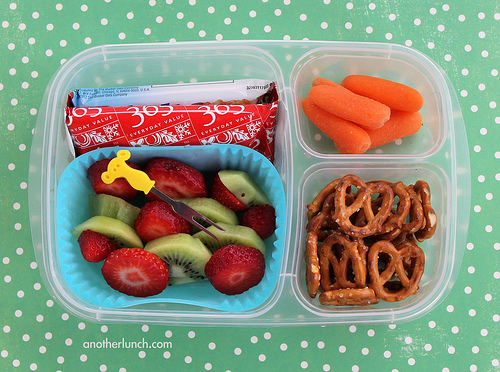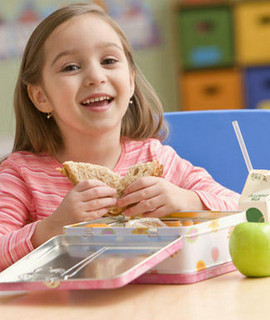
Most recently, the U.S. Department of Agriculture has proposed a new plan to eliminate junk food sold in schools.
This new plan proposed on Feb. 1, titled “Smart Snacks in Schools,” is a part of the government’s efforts to reduce childhood obesity under the Healthy, Hunger-Free Kids Act of 2010 (HHFKA).
Author, educator, and nutrition coach Dayle Hayes has an overall positive felling about this new plan, but hopes that it doesn’t force people to focus only on the issue of childhood obesity, rather help them to focus on making all children healthy.
Hayes discusses childhood obesity in her presentations, but she takes a cautious approach.
“We create this stigma against weight so that overweight children feel badly about themselves,” she said. “Lots of people get so worried about being overweight that then they don’t eat the foods that have the nutrients that they need. My approach is basically to say that our emphasis … should be on health, not just on weight or BMI.”
To create this healthy environment, the new plan would eliminate foods such as fatty chips, some sodas, and snack cakes from the cafeteria and vending machines across all campuses. Diet sodas, baked chips, and trail mix are a few of the options that could replace the less nutritional ones.
Although schools have made a significant effort over the years to offer better meals to their students, this is the first time federal regulation extends outside of the cafeteria.
“I think that if schools were good at regulating themselves they would have done it already and they haven’t,” said Hayes. “It is important for the school lunch program, I think, to provide some guidance and to be a role model.”
Bob Kuhn, assistant superintendent for operations for Flagstaff Unified School District, also feels that it is time for the federal government to step in.
“I think they need to regulate us because there are some schools that would do it for profit with whatever the kids want to eat,” he said.
The USDA would have new standards in place for calorie, fat, sugar and sodium limits on the foods sold in schools. Although there are nutritional standards for what is sold in the cafeteria, there are often “a la carte” lines selling other, unregulated food options that are available to students.
These “a la carte” lunch lines, vending machines, and snack bars would all be held to higher nutritional standards.
Under the food requirements, the first option available is that it must be a fruit, vegetable, dairy product, protein food, whole grain product, or a combination food that contains at least one-quarter cup of fruits or vegetables. The other food requirement option, if the first is not chosen, is that food sold in schools must then contain 10 percent of the daily value of a nutrient that is seen as a public health concern in the 2010 Dietary Guidelines for Americans, including calcium, potassium, fiber, or Vitamin D.
There is also specific nutrient requirement for the foods sold in schools that are broken down into great detail in the proposal. As for the calorie requirements for food, snack items are limited to 200 calories per portion and entrée items have a calorie limit of 350.
Kuhn, who feels that the FUSD has been doing a good job of offering healthy options to students already, discussed how having set calorie requirements could be a downside to the new plan. He noted how a large high school boy might need more to eat than what is offered. On the other hand, a young, elementary school girl may end up throwing half of what is on her plate away.
“There’s a lot of positives but I think sometimes it’s tough for kids and they have to be able to have a little more choice and freedom,” he said.
The beverage requirements have also been set to a higher standard. All schools may sell water, different varieties of milk, and 100 percent fruit and vegetable juices. Elementary schools can sell eight-ounce portions, while middle and high schools can sell up to 12-ounce portions of these options.
Besides the above beverages, there are additional beverage choices the new plan offers that must meet certain guidelines. Schools may serve up to 20-ounce servings of calorie-free beverages. The proposal would also allow other beverages to be sold that meet certain calorie requirements: either less than 40 calories per eight-ounce serving (or less than 60 calories per 12-ounce serving), or 50 calories per eight-ounce serving (or 75 calories per 12-ounce serving).
Agricultural Secretary Tom Vilsack commented on a statement about the new proposal in the USDA website, saying he hopes these new standards help to instill healthy food decisions in children.

Melanie Hingle, assistant research professor at the Nutritional Sciences Departmen at University of Arizona who has done extensive research in children nutrition, agrees with Vilsak that this new plan is a step in the right direction for giving children nutritional options at school.
“Kids spend a large part of their day in schools,” said Hingle. “Schools should support student learning by structuring their environments in ways that support learning. This includes healthy eating and physical activity opportunities.”
Some people, however, see an issue with the fact that the new requirements would not apply to bake sale, fundraisers, concession stands, classroom rewards, or anything a student brings from home.
Hayes, who conducts presentations on children nutrition, finds fault with this portion of the plan.
“My concern really comes down to the fact that it doesn’t apply equally across the board to all the places that snacks are served in school,” said Hayes.
One thing Hayes believes to be important in a school in order to make the changes necessary is to create a place where the entire environment is focused around health.
“What you need is a district to come together and say we want a culture of wellness because we want our students to be healthy and successful,” she said. “Schools are working really hard to make really important changes but its about so much more than just the school nutrition program, its got to be that culture of wellness in the entire school and not just on what’s going on in the cafeteria.”
A 60-day period is now occurring where schools, the food industry, and others concerned with the proposal to comment on it and suggest changes.
Shirley Sokol, the interim director for the Tucson Unified School District Food Services Department, said that she hopes this new plan can help students inside and outside of the school setting.
“The ultimate solution doesn’t come from any one person or place. We are only part of a student’s day. We can only hope that in coordination with the student, their families and peers, they will make mindful food choices,” she said.

